Parsley - description, cultivation, photo
Garden parsley has been cultivated by humans since the 9th century. The plant is used as a seasoning, to decorate dishes, giving them a spicy taste and aroma. Parsley promotes the secretion of digestive enzymes, improves intestinal tone and bile secretion, has diuretic properties and normalizes heart function.
What is parsley
Garden parsley, or curly parsley, is widely used as an edible herb and seasoning in cooking, used as a useful component in cosmetic products and traditional medicine.
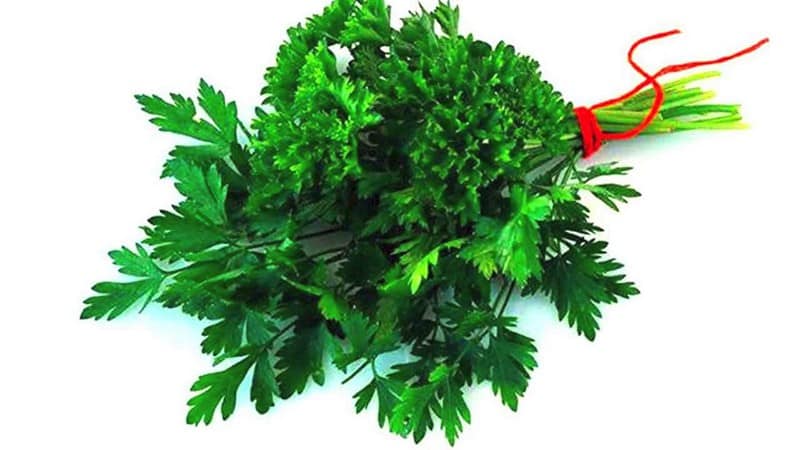
Greens contain a large number of useful substances:
- vitamins: E, C, K, B1, B2, B5, B6, B9, PP, H, beta-carotene, lutein and zeaxanthin;
- minerals: potassium, magnesium, calcium, iron, phosphorus, copper, silicon, boron, manganese, zinc;
- essential oils - up to 0.3%;
- flavonoids: luteolin, apigenin;
- phytoncides;
- pectins.
Greens are especially rich in ascorbic acid (100 g contains 431% of the daily value), vitamin K (658%), beta-carotene (111%), lutein and zeaxanthin (93%), folic acid (29%). Contains up to 46% omega-3 fatty acids, 9% phytosterols.
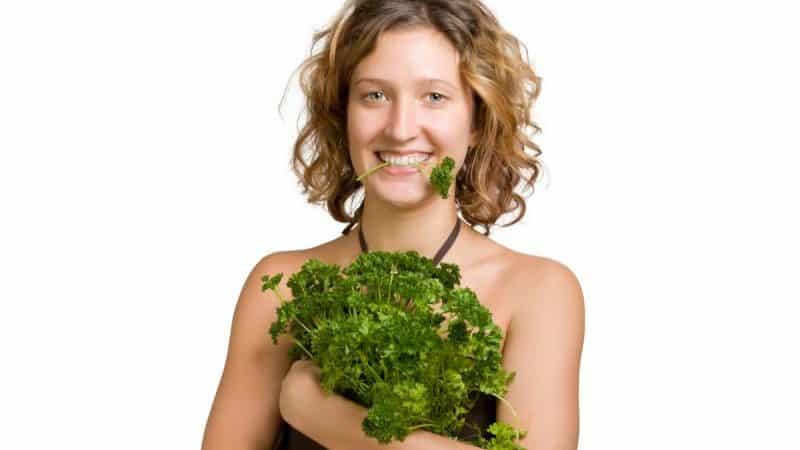
This is interesting:
Beneficial properties of parsley for women
Medicinal properties of parsley and contraindications for use
Botanical description
Parsley is a biennial, sometimes annual, herbaceous plant of the Apiaceae family with a characteristic aroma and spicy taste.
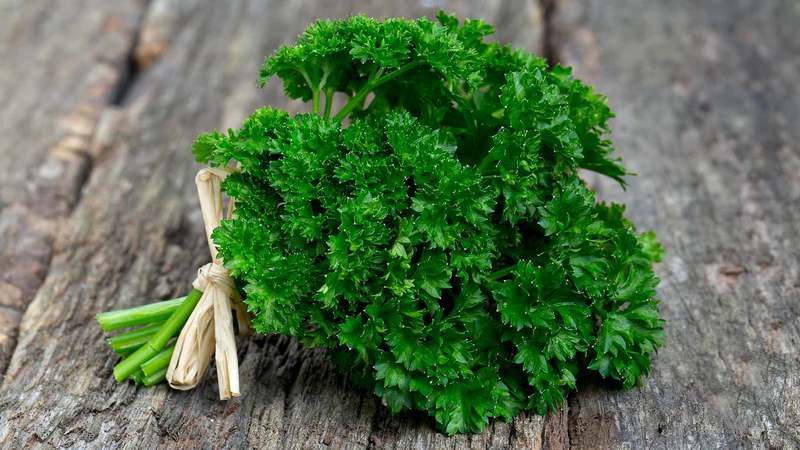
Numerous leaf blades have a triangular shape with a double and triple dissected silhouette, a shiny upper part and a matte-gray lower part. The bright green foliage can be straight or ruffled. The stem is erect, of different shades of green, from 30 to 100 cm high, with shiny triangular, double and triple crossed leaves.
The root of parsley is taprooted, cylindrical and dense, fleshy. It has a cone-shaped or spindle-shaped shape, sometimes with branching and thickening, and often reaches 30 cm in length. The outside color is pale brown or yellowish-white, with annular transverse wrinkles; when cut, it is cream or white.
The flowers are cross-pollinating, regular, five-petaled, collected in an umbrella-shaped inflorescence, small greenish-yellow or light green. The flowering period lasts for 2 months - in June-July.
Parsley fruits are small, about 3–5 mm in size, greenish-gray or grayish-brown two-seeds of oblong or round shape, which split into two half-fruits with a bitter aftertaste.
Is it a herb or vegetable
Although parsley is a herbaceous plant, it is classified as a leaf vegetable because it has edible parts - the roots. Its above-ground shoots are also suitable for cooking.
Reference! The fruits of the plant are usually used for medicinal purposes. They have diuretic, carminative properties, improve digestion, and regulate the menstrual cycle. Greens also provide similar benefits. However, parsley should not be consumed by pregnant women: it can cause premature birth and cause miscarriage.
The excellent flavor of the leaves and roots allows them to be used fresh, dry or frozen.
Perennial or annual plant
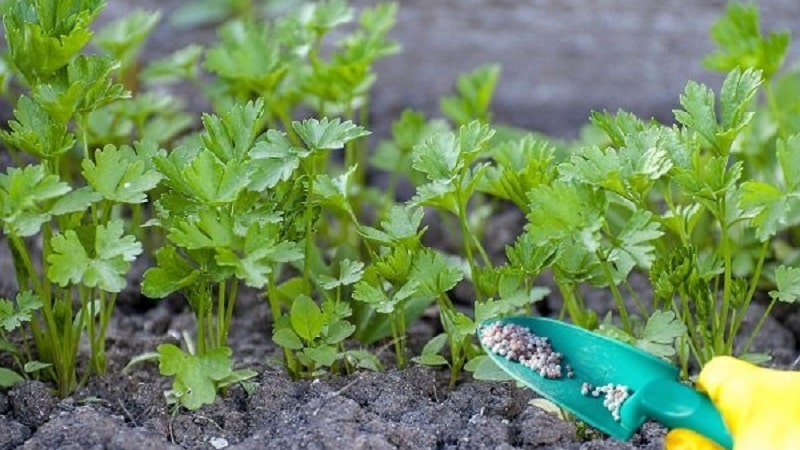
Parsley occurs as an annual and biennial plant. In the first year, a leaf rosette and a root grow - every spring new seeds are planted and greens and young roots are collected. For further development and enlargement of the root part, obtaining seeds, the plant is prepared for wintering and secondary spring germination.
In the second year, inflorescences appear and the period of seed propagation begins. At this time, parsley develops a long peduncle with complex umbrella-shaped inflorescences formed by small flowers. Later, the fruit is set with seeds, which remain viable for 2-3 years.
Is it related to algae?
Parsley belongs to higher plants and is not related to algae, which are predominantly aquatic single- or multicellular photosynthetic organisms that do not have stems, leaves, or root systems.
How parsley blooms
In the second year of plant growth and development, flower stalks and seed caps are formed. Flowering occurs equally in all types of crops. In June or early July, umbrella-shaped inflorescences appear on long shoots reaching 70–120 cm.
Each of them consists of a large number of small yellowish or greenish flowers, each having 5 heart-shaped or round petals with tips slightly curved inward. Flowering lasts 30–45 days, and after its completion, small fruits are formed, in which the seeds begin to ripen.
Important! With the appearance of flower stalks on the plant, its greenery becomes hard and rough, since all the nutrition is spent on the development of fruits.
In some cases, the formation of arrows and inflorescences is possible already in the first year of parsley growth. Most often this occurs in early autumn landing, when the seed has time to germinate, and after winter the crop perceives spring warming as a second growth cycle.
Varieties and varieties of parsley
There are two types of parsley - leaf (ordinary) and curly. The difference between them is visible in the photo of the plants.
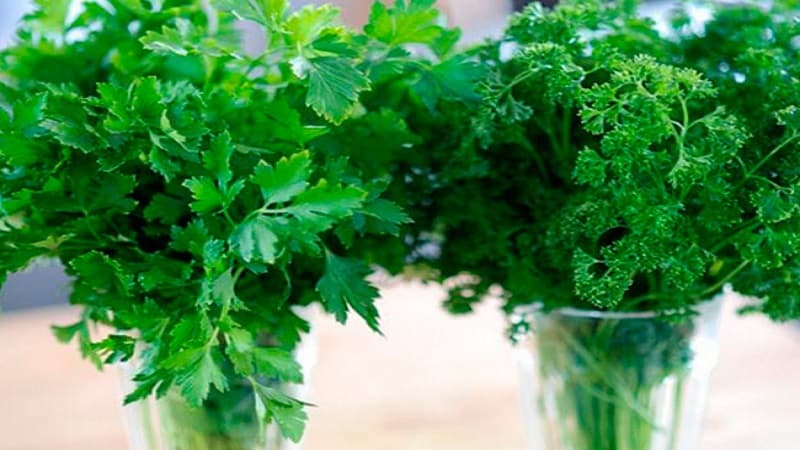
Leafy
This species is distinguished by a larger rosette of smooth leaves, a highly branched and thin root system. Leaf parsley is aromatic, its delicate greens find wide practical use, and the roots are much less commonly used in cooking.
Curly
The leaves of this species are dissected and wavy, but are tougher and less fragrant. The root is large and fleshy, weakly branched. Unlike the leaf variety, the curly variety stores better and stretches less when growing.
What are the fruits of garden parsley?
The fruits of the plant are small grayish or greenish oval or rounded ovarian fruits containing seed material. On the outside, they are coated with essential oil, which prevents moisture from entering the seeds during their formation. The fruits ripen at the end of summer.
The most productive parsley

The most productive varieties of parsley:
- Beads - leafy early ripening frost-resistant, with a yield of 1.5–2 kg of greenery per 1 m2 and ripening period 55–60 days from the moment of emergence;
- Aster is an early ripening curly, with a high yield of greenery - up to 5 kg per 1 m2, roots unsuitable for food and a ripening period of 55–65 days;
- Universal - leaf and root crops, yield - 2.5–5 kg per 1 m2, ripening occurs 60–65 days after germination;
- Petra - curly mid-season, with a yield of up to 2.5 kg per 1 m2 and ripening on 95–100 days from the moment of germination;
- Mooskrause 2 - early ripening curly, with a yield of up to 2.5 kg per 1 m2 and ripening in 55–60 days;
- Eagle - mid-season root, with a yield of 4–9 kg per 1 m2 and complete root maturation within 120–130 days;
- Natalka - early leaf, yield - up to 3 kg per 1 m2, ripening period - 55–65 days;
- Plain is a late-ripening leafy plant that produces 2.5–3 kg of greens in 80–130 days.
What is another name for parsley?
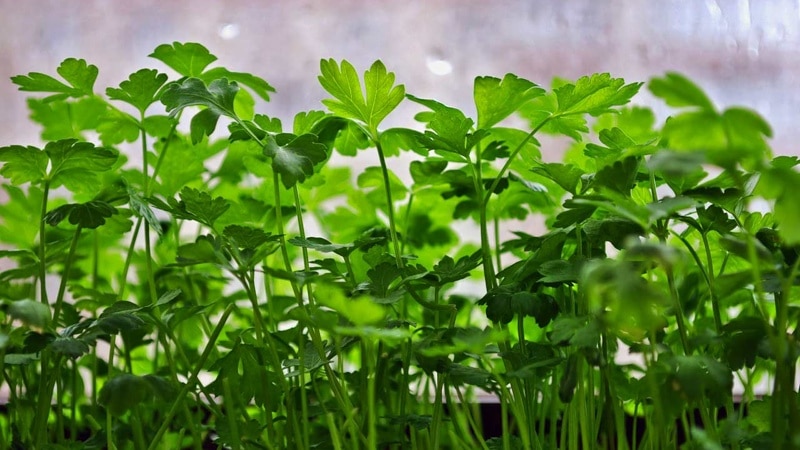
Garden parsley has other names:
- bride, petrosilia - folk names;
- petroselinium - an ancient designation translated as “growing on stones”;
- pestrets, sverbiguz - old Russian names.
Conclusion
The widely known plant parsley is a leafy vegetable; not only its aromatic, spicy herbs are used in cooking, but also its roots. Roots, like leaves, dried and frozen for the winter, added to soups and stewed vegetables. Due to its rich chemical composition, the plant is used for medicinal purposes and in cosmetology (for nutrition, whitening and toning facial skin, strengthening hair).